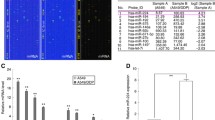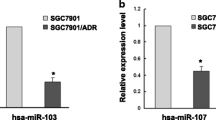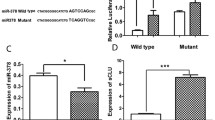Abstract
MicroRNAs (miRNAs) are short non-coding RNA molecules, which posttranscriptionally regulate genes expression and play crucial roles in diverse biological processes, such as development, differentiation, apoptosis, and proliferation. Here, we investigated the possible role of miRNAs in the development of multidrug resistance (MDR) in human gastric and lung cancer cell lines. We found that miR-497 was downregulated in both multidrug-resistant human gastric cancer cell line SGC7901/vincristine (VCR) and multidrug-resistant human lung cancer cell line A549/cisplatin (CDDP) and the downregulation of miR-497 was concurrent with the upregulation of BCL2 protein, compared with the parental SGC7901 and A549 cell lines, respectively. In vitro drug sensitivity assay demonstrated that overexpression of miR-497 sensitized SGC7901/VCR and A549/CDDP cells to anticancer drugs, respectively. The luciferase activity of BCL2 3′-untranslated region-based reporter constructed in SGC7901/VCR and A549/CDDP cells suggested that BCL2 was the direct target gene of miR-497. Enforced miR-497 expression reduced BCL2 protein level and sensitized SGC7901/VCR and A549/CDDP cells to VCR-induced and CDDP-induced apoptosis, respectively. Taken together, our findings first suggested that has-miR-497 could play a role in both gastric and lung cancer cell lines at least in part by modulation of apoptosis via targeting BCL2.





Similar content being viewed by others
Abbreviations
- miRNAs:
-
MicroRNAs.
- MDR:
-
Multidrug resistance.
- VCR:
-
Vincristine.
- CDDP:
-
Cisplatin
- 5-Fu:
-
5-fluorouracil
- VP-16:
-
Etoposide
- ADR:
-
Adriamycin
References
Lippert TH, Ruoff HJ, Volm M. Intrinsic and acquired drug resistance in malignant tumors. The main reason for therapeutic failure. Arzneimittelforschung. 2008;58:261–4.
Rabik CA, Dolan ME. Molecular mechanisms of resistance and toxicity associated with platinating agents. Cancer Treat Rev. 2007;33:9–23.
Johnstone RW, Ruefli AA, Lowe SW. Apoptosis: a link between cancer genetics and chemotherapy. Cell. 2002;108:153–64.
Zhang K, Mack P, Wong KP. Glutathione-related mechanisms in cellular resistance to anticancer drugs. Int J Oncol. 1998;12:871–82.
Szakacs G, Paterson JK, Booth-Genthe C, Gottesman MM. Targeting multidrug resistance in cancer. Nat Rev Drug Disc. 2006;5:219–34.
Fojo T. Multiple paths to a drug resistance phenotype: mutations, translocations, deletions and amplification of coding genes or promoter regions, epigenetic changes and microRNAs. Drug Resist Updat. 2007;10(1–2):59–67.
Glasspool RM, Teodoridis JM, Brown R. Epigenetics as a mechanism driving polygenic clinical drug resistance. Br J Cancer. 2006;94(8):1087–92.
Sharma SV, Lee DY, Li B, Quinlan MP, Takahashi F, Maheswaran S, McDermott U, Azizian N, Zou L, Fischbach MA, Wong KK, Brandstetter K, Wittner B, Ramaswamy S, Classon M, Settleman J. A chromatin-mediated reversible drug-tolerant state in cancer cell subpopulations. Cell. 2010;141(1):69–80.
Rosalind C. Lee, Rhonda L. Feinbaum, Victor Ambros. The C. elegans heterochronic gene lin-4 encodes small RNAs with antisense complementarity to lin-14. Cell. 1993;75(5):843–54.
Zheng T, Wang J, Chen X, Liu L. Role of microRNA in anticancer drug resistance. Int J Cancer. 2010;126:2–10.
Hummel R, Hussey DJ, Haier J. MicroRNAs: predictors and modifiers of chemo- and radiotherapy in different tumour types. Eur J Cancer. 2010;46(2):298–311.
Ma J, Dong C, Ji C. MicroRNA and drug resistance. Cancer Gene Ther. 2010;17(8):523–31.
Fazlul H. Sarkar, Yiwei Li, ZhiweiWang, Dejuan Kong, Shadan Ali. Implication of microRNAs in drug resistance for designing novel cancer therapy. Drug Resist Updat. 2010;13(3):57–66.
Chen GQ, Zhao ZW, Zhou HY, Liu YJ, Yang HJ. Systematic analysis of microRNA involved in resistance of the MCF-7 human breast cancer cell to doxorubicin. Med Oncol. 2010;27(2):406–15.
Bourguignon LY, Spevak CC, Wong G, Xia W, Gilad E. Hyaluronan-CD44 interaction with protein kinase C (epsilon) promotes oncogenic signaling by the stem cell marker Nanog and the Production of microRNA-21, leading to down-regulation of the tumor suppressor protein PDCD4, anti-apoptosis, and chemotherapy resistance in breast tumor cells. J Biol Chem. 2009;284(39):26533–46.
Li Y, Li W, Yang Y, Lu Y, He C, Hu G, Liu H, Chen J, He J, Yu H. MicroRNA-21 targets LRRFIP1 and contributes to VM-26 resistance in glioblastoma multiforme. Brain Res. 2009;1286:13–8.
Xia L, Zhang D, Du R, Pan Y, Zhao L, Sun S, Hong L, Liu J, Fan D. miR-15b and miR-16 modulate multidrug resistance by targeting BCL2 in human gastric cancer cells. Int J Cancer. 2008;123:372–9.
Zhu W, Shan X, Wang TS, Shu YQ, Liu P. miR-181b modulates multidrug resistance by targ eting BCL2 in human cancer cell lines. Int J Cancer. 2010;127(11):2520–9.
Livak KJ, Schmittgen TD. Analysis of relative gene expression data using real-time quantitative PCR and the 2(-Delta Delta C(T)) Method. Methods. 2001;25:402–8.
Yamaue H, Tanimura H, Noguchi K, Hotta T, Tani M, Tsunoda T, Iwahashi M, Tamai M, Iwakura S. Chemosensitivity testing of fresh human gastric cancer with highly purified tumor cells using the MTT assay. Br J Cancer. 1992;66:794–9.
Yamaue H, Tani M, Onishi H, Kinoshita H, Nakamori M, Yokoyama S, Iwahashi M, Uchiyama K. Locoregional chemotherapy for patients with pancreatic cancer intraarterial adjuvant chemotherapy after pancreatectomy with portal vein resection. Pancreas. 2002;25:366–72.
Wang S, Yang D, Lippman ME. Targeting Bcl-2 and Bcl-XL with nonpeptidic small-molecule antagonists. Semin Oncol. 2003;30:133–42.
Reed JC. Drug insight: cancer therapy strategies based on restoration of endogenous cell death mechanisms. Nat Clin Prac Oncol. 2006;3:388–98.
Finnerty JR, Wang WX, Hébert SS, Wilfred BR, Mao G, Nelson PT. The miR-15/107 group of microRNA genes: evolutionary biology, cellular functions, and roles in human diseases. J Mol Biol. 2010;402(3):491–509.
Flavin RJ, Smyth PC, Laios A, O’Toole SA, Barrett C, Finn SP, Russell S, Ring M, Denning KM, Li J, Aherne ST, Sammarae DA, Aziz NA, Alhadi A, Sheppard BL, Lao K, Sheils OM, O’Leary JJ. Potentially important microRNA cluster on chromosome 17p13.1 in primary peritoneal carcinoma. Mod Pathol. 2009;22(2):197–205.
Chang TC, Yu D, Lee YS, Wentzel EA, Arking DE, West KM, Dang CV, Thomas Tikhonenko A, Mendell JT. Widespread microRNA repression by Myc contributes to tumorigenesis. Nat Genet. 2008;40(1):43–50.
Bloomston M, Frankel WL, Petrocca F, et al. MicroRNA expression patterns to differentiate pancreatic adenocarcinoma from normal pancreas and chronic pancreatitis. JAMA. 2007;297:1901–8.
Yin KJ, Deng Z, Huang H, Hamblin M, Xie C, Zhang J, Chen YE. miR-497 regulates neuronal death in mouse brain after transient focal cerebral ischemia. Neurobiol Dis. 2010;38(1):17–26.
Acknowledgments
The authors are grateful to the fund support by the National Natural Science Foundation of China (Grant number: 30840095) and the Cancer Center of Nanjing Medical University (Grant number: 08ZLKF02).
Author information
Authors and Affiliations
Corresponding author
Additional information
Wei Zhu and DanXia Zhu equally contributed to this study.
Electronic supplementary material
Below is the link to the electronic supplementary material.
Rights and permissions
About this article
Cite this article
Zhu, W., Zhu, D., Lu, S. et al. miR-497 modulates multidrug resistance of human cancer cell lines by targeting BCL2. Med Oncol 29, 384–391 (2012). https://doi.org/10.1007/s12032-010-9797-4
Received:
Accepted:
Published:
Issue Date:
DOI: https://doi.org/10.1007/s12032-010-9797-4




